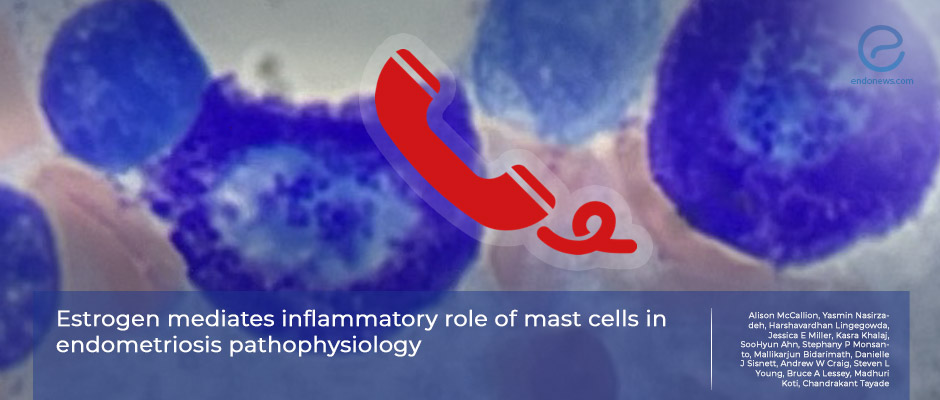A call for mast cells from endometriotic lesions
Sep 30, 2022
What is to blame? Mast cell?
Key Points
Highlights:
- Endometriotic lesions recruit mast cells and the gathering increases under estrogen treatment.
Importance:
- The study picks up an inflammatory cell, mast cell, and identifies its effects on endometriosis growth and manipulations in the estrogenic environment.
What's done here:
- Eutopic endometrium, endometriosis tissue, and peritoneal fluid of 14 advanced stage endometriosis patients and 8 eutopic endometria from healthy women have been analyzed.
- To evaluate the mast cell requirement, qPCR analysis of mast cell-interest genes (IL1B, VCAM1, TAC1, TPSAB1, CPA3, IL3, CCL2, TNF, CCR1), and of stem cell factor which is important for mast cell proliferation was examined.
- To scrutinize the interaction between mast cells and the endometriotic microenvironment, endometriotic epithelial cells, and endometrial stromal cells were incubated in vitro with mast cell-conditioned media.
- To understand the effect of estrogen on mast cells, the endometriosis mice model has been treated with estrogen, and mast cell count and qPCR analysis of activated genes have been evaluated.
Key Results:
- Transcription levels for mast-cell-related genes showed significant differences between the endometriotic lesion and normal endometrium leading to the recruitment of mast cells on endometriotic tissues.
- The stem cell factor concentrations have been significantly higher in endometriotic lesions compared to the same patient’s eutopic endometrium referring to a chemotactic call for mast cells from endometriotic tissues.
- Endometriotic epithelial cells and endometrial stromal cells gathered with mast cells showed an increased production of pro-inflammatory and chemokinetic cytokines, meaning a call for mast cells from stromal and epithelial cells.
- The count of mature mast cells in peritoneal fluid of estrogen-treated mice, and also the number of activated genes on treated endometriotic lesions compared to untreated mice showed a significant increase, confirming the effect of estrogen on mast cell count.
Limitations:
- It is a detailed well-designed study and the results should be replicated in further studies using mast cell-specific mouse models.
Lay Summary
Endometriosis is a well-known hormonal-dependent inflammatory disease. But what type of inflammatory cells is responsible, and when does estrogen take part, are questions that have not been answered yet.
In the study conducted by Alison McCallion et al, the role of mast cells and the underlying mechanisms are analyzed. The researchers have sought answers from endometriotic lesions, endometrial cell cultures, and mouse models of endometriosis.
Endometrium, endometriosis tissue, and peritoneal fluid of 14 advanced stage endometriosis patients and 8 eutopic endometria from healthy women were analyzed. To show mast cell requirement in the above materials, the analysis of mast cell-related genes (IL1B, VCAM1, TAC1, TPSAB1, CPA3, IL3, CCL2, TNF, CCR1) and the analysis of stem cell factor which is important for mast cell proliferation were applied. In order to examine the interaction between mast cells and the endometriotic lesion microenvironment, cultured endometriotic epithelial cells and endometrial stromal cells were incubated with mast cell-conditioned media. Furthermore, to understand the effect of estrogen on mast cells, an endometriosis model of mice has been treated with estrogen, mast cells were quantified, also activated genes were examined.
The transcription levels for the above genes showed significant differences between the endometriotic lesion and normal endometrium leading to the recruitment of mast cells on endometriotic tissues. The stem cell factor concentrations were significantly higher in endometriotic lesions compared to the same patient’s eutopic endometrium referring to a chemotactic call for mast cells from endometriotic tissues. Endometriotic epithelial cells and endometrial stromal cells gathered with mast cells showed a significantly increased production of pro-inflammatory and chemokinetic cytokines, meaning a call for mast cells from stromal and epithelial cells. Also, the count of mature mast cells in peritoneal fluid of estrogen-treated mice and as well as the number of activated genes on treated endometriotic lesions showed a significant increase compared to untreated mice, displaying the effect of estrogen on endometriotic tissue mast cell count.
Overall, in this article which was recently published in Frontiers in Immunology, findings also knock on the door of immune modulation therapies that are to be considered in future studies.
Research Source: https://pubmed.ncbi.nlm.nih.gov/36016927/
mast cells immune modulation endometriosis stem cell factor IL1B VCAM interleukin CCL TNF CCR

